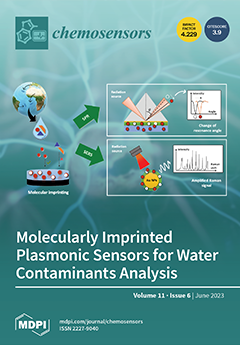Mesoporous silica materials have been widely used as gas adsorbents due to their excellent adsorption ability, large specific surface area, simple preparation process, and convenient functionalization. In this study, a core–shell mesoporous material MCM-41@SiO
2 was synthesized and functionalized by CoCl
2,
[...] Read more.
Mesoporous silica materials have been widely used as gas adsorbents due to their excellent adsorption ability, large specific surface area, simple preparation process, and convenient functionalization. In this study, a core–shell mesoporous material MCM-41@SiO
2 was synthesized and functionalized by CoCl
2, and subsequently KSCN, to prepare an ammonia adsorbent. The adsorbent was proved to possess high surface area, good sphericity, uniform size, good dispersibility, and high adsorption capability following DLS, SEM, TEM, and a static adsorption study. Moreover, the successful functionalization and thermal stability were confirmed by FT-IR, XPS, and TGA. The material was then used to fabricate a glass tube sensor for the rapid naked-eye detection of ammonia gas. The sensor showed good performance in terms of sensing speed, selectivity, accuracy, and reusability. Within 5 s, NH
3 could be detected by the discoloration, and a wide NH
3 concentration from 20 to 1000 ppm could be detected. It also showed a good linear relationship between discoloration length and ammonia concentration. A reversible color change from blue to yellow indicated the presence of NH
3, which was attributed to the formation and disassembly of ammonia-containing complex [Co(NH
3)
6(NCS)
2]. With fast adsorption, naked-eye sensing properties, and good selectivity, the sensor holds good promise for indoor NH
3 sensing and other more complicated situations.
Full article





